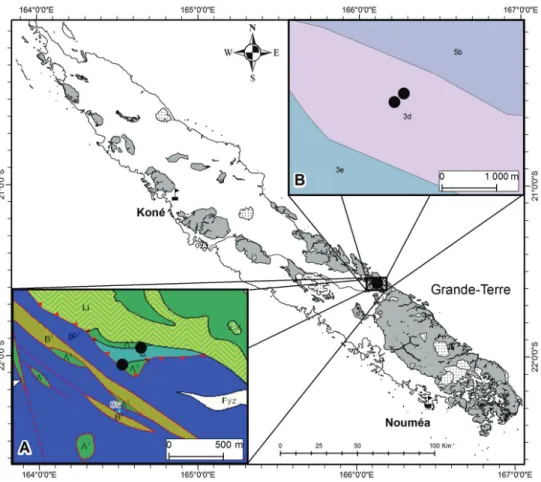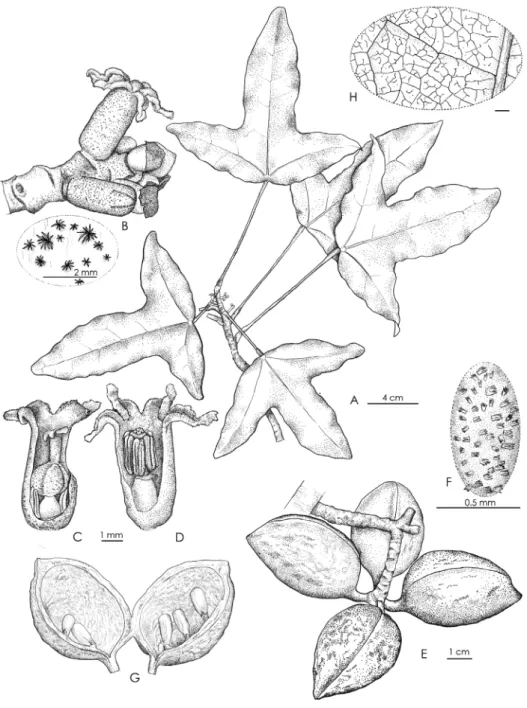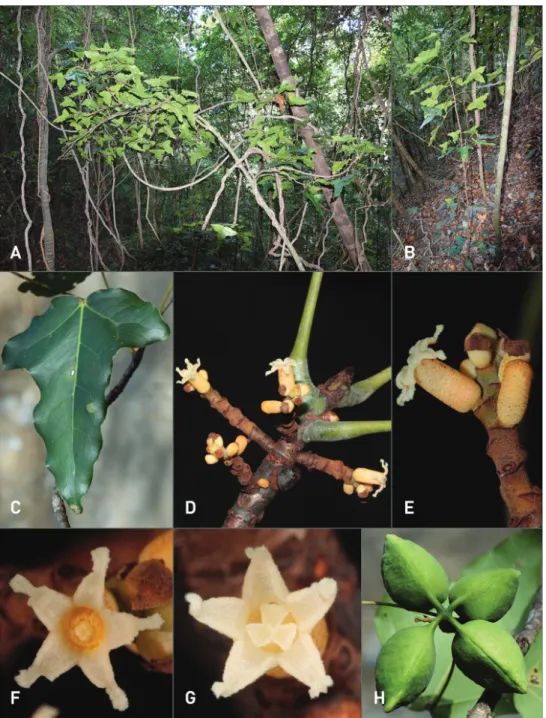HAL Id: hal-02057767
https://hal.umontpellier.fr/hal-02057767
Submitted on 25 Nov 2019HAL is a multi-disciplinary open access archive for the deposit and dissemination of sci-entific research documents, whether they are pub-lished or not. The documents may come from teaching and research institutions in France or abroad, or from public or private research centers.
L’archive ouverte pluridisciplinaire HAL, est destinée au dépôt et à la diffusion de documents scientifiques de niveau recherche, publiés ou non, émanant des établissements d’enseignement et de recherche français ou étrangers, des laboratoires publics ou privés.
Distributed under a Creative Commons Attribution| 4.0 International License
Novitates neocaledonicae X: A very rare and threatened
new microendemic species of Acropogon (Malvaceae,
Sterculioideae) from New Caledonia
Gildas Gâteblé, Jérôme Munzinger
To cite this version:
Gildas Gâteblé, Jérôme Munzinger. Novitates neocaledonicae X: A very rare and threatened new microendemic species of Acropogon (Malvaceae, Sterculioideae) from New Caledonia. PhytoKeys, Pensoft, 2018, 110 (110), pp.1-8. �10.3897/phytokeys.110.27599�. �hal-02057767�
Novitates neocaledonicae X: A very rare and threatened
new microendemic species of Acropogon (Malvaceae,
Sterculioideae) from New Caledonia
Gildas Gâteblé1, Jérôme Munzinger2
1 Institut Agronomique néo-Calédonien (IAC), Equipe ARBOREAL, BP 711, 98810 Mont-Dore, New Caledonia 2 AMAP, IRD, CIRAD, CNRS, INRA, Université Montpellier, F-34000 Montpellier, France
Corresponding author: Gildas Gâteblé (gateble@iac.nc)
Academic editor: Laurence J. Dorr | Received 26 June 2018 | Accepted 10 October 2018 | Published 26 October 2018
Citation: Gâteblé G, Munzinger J (2018) Novitates neocaledonicae X: A very rare and threatened new microendemic
species of Acropogon (Malvaceae, Sterculioideae) from New Caledonia. PhytoKeys 110: 1–8. https://doi.org/10.3897/ phytokeys.110.27599
Abstract
A new species, Acropogon horarius Gâteblé & Munzinger, sp. nov. (Malvaceae, Sterculioideae), is described from New Caledonia. It is known only from two very small subpopulations in the rainforests of the Petchécara Pass between Thio and Canala, in the southeast of Grande-Terre, New Caledonia’s main island. This shrub to small tree has hastate leaves and minute sessile tubular whitish-yellowish flowers and is strik-ingly different from all other members of the genus. The type locality is geologically complex and located within one of only four amphibolite lenses known in New Caledonia. A line drawing and colour photos are provided for the new species, along with a preliminary risk of extinction assessment, which indicates that the species is Critically Endangered.
Keywords
Acropogon, geology, Malvaceae, New Caledonia, new species, Sterculioideae, taxonomy, threatened species
Introduction
The endemic New Caledonian genus Acropogon Schltr. (Malvaceae, Sterculioideae) comprises 26 currently recognised species (Munzinger and Gâteblé 2017). A puta-tively undescribed species of Acropogon was recently found by Jean-Jacques Villegente and Jacqueline Ounémoa in the rainforests of the Petchécara Pass and reported to the
http://phytokeys.pensoft.net
Copyright G. Gâteblé, J. Munzinger. This is an open access article distributed under the terms of the Creative Commons Attribution License (CC BY 4.0), which permits unrestricted use, distribution, and reproduction in any medium, provided the original author and source are credited.
G. Gâteblé & J. Munzinger / PhytoKeys 110: 1–8 (2018)
2
first author. This part of New Caledonia, along the locally famous and last remaining “scheduled road” or “route à horaire” along which traffic between the towns of Thio and Canala and above the Dothio river alternates one direction then the other, is not very well known from a botanical perspective. The place where the putative new species grows is also interesting geologically as it is at the edge of a peridotite massif, on one of only four rare amphibolite lenses known in New Caledonia (Cluzel et al. 2012) and close to or within a serpentinite vein according to the geological map of the territory (Gouvernement de la Nouvelle-Calédonie 2018; Fig. 1A). In such places of geologi-cal complexity, a large diversity of soils derived from the initial parent material can be found and it is often difficult to characterise the soils precisely (Fritsch 2012; Fig. 1B). However, it is important to conserve these contact zones between soil types to main-tain evolutionary processes such as speciation and hybridisation (Pillon et al. 2009).
Figure 1. Distribution of Acropogon horarius Gâteblé & Munzinger sp. nov. mapped on the geological (A)
and soil (B) GIS layers of the Petchécara Pass. Insert A, geology from Gouvernement de la Nouvelle-Calé-donie (2018): Λ1, serpentinites; Δ, amphibolites; B1, undifferentiated poly-metamorphic substrate; βP1, un-differentiated basalts and dolerites; Fyz, recent and extant alluvial; Li, listwanites. Insert B, soils from Fritsch (2012): 3d, haplic cambisol combined with lithic leptosol on peridotites; 3e, ferralic cambisol combined with haplic ferralsol on volcano-sedimentary and metamorphic rocks; 5b, posic ferralsol on peridotites.
In this paper, we describe and illustrate a morphologically distinctive new Acropo-gon species. We also provide a risk of extinction assessment based on the IUCN Red List Categories and Criteria (IUCN 2017).
Materials and methods
In order to determine whether the material from the Petchécara Pass belonged to a currently recognised species or represented a new member of the genus, we care-fully examined and measured living specimens and herbarium material. We focused on morphological characters recognised by previous authors (Schlechter 1906; Morat 1986, 1988; Morat and Chalopin 2003, 2005, 2007; Callmander et al. 2015) as be-ing taxonomically informative within the genus. Undetermined herbarium specimens from MPU, NOU and P were studied to assess whether additional material had also been collected previously. The new species was also observed in the field and under cul-tivation. In order to obtain specimens of the minute and fragile flowers, a fertile branch (cutting) with flower buds was placed in a propagation house (22 °C ± 2 °C, 95% relative humidity) for one month to gather flowers in alcohol as soon as they opened. Descriptions of colour pertain to material seen in vivo, unless otherwise noted.
Taxonomy
Acropogon horarius Gâteblé & Munzinger, sp. nov.
urn:lsid:ipni.org:names:77191339-1
Figures 2, 3
Diagnosis. Acropogon horarius Gâteblé & Munzinger differs from all other members of
the genus by the combination of its long and thin petioles, hastate and cordate leaves and minute sessile tubular whitish-yellowish flowers.
Type. New Caledonia. Province Sud: Thio, Col de Petchécara, route à horaire,
200 m alt., 21°34'41.01"S, 166°07'22.41"E, 25 Aug 2016, G. Gâteblé, J. Ounémoa, M. Moenteapo & E. Poitchili 806 (holotype: P00722668; isotypes: K, MPU311373, NOU088956, P00722670).
Description. Monoecious shrub to small tree up to 6 m tall, sparsely branched with
usually a main trunk less than 7 cm in d.b.h.; bark brown, with conspicuous scars left by the caducous cataphylls and sometimes petioles of upper leaves subtending the terminal bud. Leaves clustered at the apex of branches on adult plants, branches 4–5 mm in di-ameter; petioles light green to yellow (greyish to orange in herbarium material), strongly different in colour than the branch, glabrous, (6.5–)9.0–12.0(–15.5) cm long, 1–2 mm in diameter, elliptical in cross section (in vivo), slightly striate (in herbarium material), enlarged (3–4 mm) proximally and distally, the pulvini slightly pruinose (in vivo); blades simple, coriaceous, flat, slightly discolorous, glabrous on both surfaces, unlobed to slight-ly hastate on juvenile plants (Gâteblé et al. 804), rareslight-ly unlobed to strongslight-ly trilobed or
G. Gâteblé & J. Munzinger / PhytoKeys 110: 1–8 (2018)
4
hastate on adult plants, (10.5–)12.5–15.0(–16.0) cm long, (6.0–)11.5–18.0(–23.5) mm wide, base cordate (rarely truncate), apex of the lobes broadly acute to rounded; generally with 3 strong primary palmate veins, primary and secondary veins prominent abaxially, conspicuously different in colour (yellow-orange in herbarium material and light green to yellowish in vivo) than the blade, reticulum visible abaxially (and adaxially in herb.), secondary veins 2–5 pair; tertiary and quaternary veins finely reticulate with scattered crateriform glands 25–35 µm. Inflorescence a reduced spike-like raceme, axillary within, above or just below the terminal cluster of leaves, up to 3.5 cm long, 2.5–3.5 mm in diameter, axes greenish-yellowish, covered with a dense rust-brown indumentum com-posed of minute stellate trichomes ca. 90 µm x 90 µm, bracts covered with rust-brown tomentum adaxially. Pedicels minute. Male and female flowers seemingly randomly dis-tributed within the inflorescence, solitary, of the same size. Calyx tubular, 4–5 mm long, 2–2.5 mm in diameter, yellowish and with scattered rust-brown stellate trichomes out-side, whitish and glabrous inout-side, lobes 5, triangular, 1–1.5 mm long, ending in an apical appendage 0.5–1 mm long, interior margins of the lobes and appendages covered with papillose glandular trichomes 35–55 µm long, 15–20 µm in diameter. Male flowers: androecium ca. 4 mm long; androphore tubular, ca. 2 mm long, 0.7–1 mm in diameter, with a few scattered glands; stamens 6–8, ca. 1.7 mm long, inserted at apex of andro-phore; anther dehiscence longitudinal, extrorse. Female flowers: gynophore ovoid, ca. 1 mm in diameter, with a few scattered glands; staminodes 5–7, composed of sessile, sterile anthers, ca. 1.3 mm long, inserted at the base of the gynophore; ovary ovoid, 1.5–2 mm in diameter, with 3–4 carpels, covered by a dense indumentum of stellate trichomes; style ca. 1 mm long, with scattered stellate trichomes; stigmas 3 or 4 ovoid, 0.4–0.5 mm long. Infructescence 7–12 cm wide, borne on a peduncle 0.5–3 cm long, 2.5–3.5 mm in diameter. Fruit comprising 1–4 follicle(s), each borne on a pedicel 0.5–0.8 cm long, 0.2–0.3 cm in diameter at maturity, green and turning greenish-yellow towards maturity, covered by sparse, erect, stellate trichomes, each follicle ellipsoid to ovoid, 3.5–4.5 cm long, 2.5–3 cm wide, with a woody pericarp ca. 0.2 cm thick in dry material (ca. 0.3 cm in alcohol), apex apiculate. Seeds 4–6 per locule, ellipsoid, white when immature, light brown to black at maturity, 10–12 × 4–6 mm in diameter.
Distribution and ecology. The new species is only known from the south-eastern
part of the Grande-Terre, at the Petchécara Pass between Thio and Canala (Fig. 1), where it grows on slopes in rainforest on a soil of complex geological origin.
Cultivation note. Young plantlets of Acropogon horarius are fairly easy to grow
in nursery conditions. Shrubs have been grown in a private nursery (Eriaxis nurs-ery) and at the research station of Institut Agronomique néo-Calédonien located in Saint-Louis, Mont-Dore.
Etymology. The plant is named after the last of New Caledonia’s scheduled roads
or “route à horaire” along which it grows.
Discussion. With its hastate and cordate leaves and its long and thin petioles,
its minute sessile tubular whitish-yellowish flowers, Acropogon horarius cannot be confused with any other member of this endemic genus. In fact, the morphologi-cal characters of its inflorescence [reduced spike-like raceme of solitary (sub)sessile flowers versus true racemes and panicles in other species] and flowers (tubular versus
Figure 2. Acropogon horarius Gâteblé & Munzinger sp. nov. A flowering branch B inflorescence and a
zoom on stellate trichomes of the flower tube C female flower D male flower E infructescence F detail of erect stellate trichomes on the follicle’s surface G detail of an open follicle H close-up of the abaxial leaf reticulum. Drawings by Laurence Ramon (A–H Gâteblé et al. 806).
cup shaped in the other taxa) appear to be unique in the genus. A phylogenetic study would be worthwhile to determine whether A. horarius belongs to a distinct clade within the genus. The very slow development of the inflorescence axis (or
brachy-G. Gâteblé & J. Munzinger / PhytoKeys 110: 1–8 (2018)
6
Figure 3. Acropogon horarius Gâteblé & Munzinger sp. nov. A overview of a single mature shrub in habitat B juvenile plant C leaf D flowering branch E inflorescence F male flower G female flower H follicles.
Pho-tographs by G. Gâteblé (A Gâteblé et al. 803 B Gâteblé et al. 804 C–H Gâteblé et al. 806).
blast), which takes several months, is also unusual as it appears to produce flowers sequentially throughout its growth, perhaps until there is a successful fruit set or until the axis becomes too long (3.5 cm) to produce more flowers, as opposed to the
much more nearly synchronous flowering in all other species. The combination of a prolonged duration of flowering and the unusual morphology of the minute tubular flowers suggests that the breeding mechanism in A. horarius may be different from that of other members of the genus.
Preliminary conservation status (IUCN 2017). Acropogon horarius is known
from only two very small subpopulations on both sides of the road from Thio to Canala and distant from each other by less than 300 m. In the upper subpopulation, about 10 mature individuals were seen whereas only 5 were recorded in the lower subpopulation. During fieldwork, invasive deer (Rusa timorensis) were observed in the area and regeneration on the dry forest floor of the upper population is very poor. Deer do not seem to graze the leaves of this Acropogon but the habitat is threatened by ero-sion and reduced regeneration. The lower subpopulation does not seem to be as badly impacted by deer as regeneration is better there, erosion is lower and the forest floor is more moist. However, in the lower subpopulation some rat predation of immature fruits and seeds was observed directly on the trees (see predation marks on fruits of Gâteblé et al. 805) and black rat (Rattus rattus) predation of fruits was recently reported to be a threat for most Acropogon species (Munzinger and Gâteblé 2017). Inasmuch as the two subpopulations are so close to each other, they can be considered as a single location with respect to the main threat (deer). With an EOO and AOO respectively much smaller than 100 km2 and 10 km2 and with a projected decline in habitat qual-ity, number of subpopulations and mature trees, the species qualifies as Critically En-dangered for the IUCN criterion B. Additionally, given that fewer than 50 mature individuals are known, this Acropogon also qualifies as CR under criterion C and also under criterion D when combined with a predicted decline in the number of mature individuals. Acropogon horarius is therefore assigned a preliminary status of Critically Endangered, CR B1ab(iii,iv,v)+2ab(iii,iv,v), C1+2a(i), D, based on the IUCN Red List Categories and Criteria (IUCN 2017).
Additional specimens examined. NEW CALEDONIA. Province Sud: Thio,
Col de Petchécara, route à horaire, 200 m alt., 21°34'41.01"S, 166°07'22.41"E, 25 Aug 2016, G. Gâteblé, J. Ounémoa, M. Moenteapo & E. Poitchili 805 (MPU311374, NOU088958, P00722669), Ibid., 270 m alt., 21°34'36"S, 166°07'28"E, 25 Aug 2016, G. Gâteblé, J. Ounémoa, M. Moenteapo & E. Poitchili 804 (NOU088959, P00722672), Ibid., 25 Aug 2016, G. Gâteblé, J. Ounémoa, M. Moenteapo & E. Poitchili 803 (K, MEL, MPU311375, NOU088960, P00722671), Ibid., 200 m alt., 21°34'41.01"S, 166°07'22.41"E, 3 Aug2017, G. Gâteblé & J. Taramoin 981 (MO, MPU311376, NOU088957, P00722674).
Acknowledgements
We thank Jean-Jacques Villegente and Jacqueline Ounémoa, who first noticed the new species in the field and Jacqueline Ounémoa, Joanney Taramoin, Michel Moenteapo and Edmond Poitchili for enthusiastic help spotting plants in the forests of Petchécara Pass. We are grateful to the team at the NOU herbarium (IRD, Nouméa) and Jacqueline
G. Gâteblé & J. Munzinger / PhytoKeys 110: 1–8 (2018)
8
Tinel and Giliane Karnadi-Abdelkader, for mounting and computerising the specimens, Laurence Ramon for providing the fine illustration of Figure 2 and Armelle Tardivel for the mounting of Figure 3. We thank the authorities of New Caledonia’s Southern Prov-ince for providing collecting permits and Gordon McPherson (MO) for his careful Eng-lish proofreading. Many thanks also to Pete Lowry who has provided numerous valuable comments on a previous version of the manuscript and to the editor, Laurence J. Dorr.
References
Callmander MW, Munzinger J, Buerki S, Lowry II PP (2015) Novitates neocaledonicae II: Acropogon moratianus (Malvaceae, Sterculieae): A rare and threatened new species from New Caledonia. Adansonia sér. 3 37: 131–137. https://doi.org/10.5252/a2015n1a8 Cluzel D, Jourdan F, Meffre S, Maurizot P, Lesimple S (2012) The metamorphic sole of New
Caledonia ophiolite: 40Ar/39Ar, U-Pb, and geochemical evidence for subduction inception
at a spreading ridge. Tectonics 31(3): TC3016. https://doi.org/10.1029/2011TC003085 Fritsch E (2012) Les sols. In: Bonvallot J, Gay J-C, Habert E (Eds) Atlas de la
Nouvelle-Calé-donie. IRD-Congrès de la Nouvelle-Calédonie, Marseille-Nouméa, 73–76.
Gouvernement de la Nouvelle-Calédonie (2018) Explorateur cartographique Géorep.nc. htt-ps://arcg.is/KW41n [Accessed 25 June 2018]
IUCN (2017) Guidelines for Using the IUCN Red LIst Categories and Criteria. Version 13. Prepared by the Standards and Petitions Subcommittee. http://www.iucn.org/RedList-Guidelines.pdf [Accessed 25.06.2018]
Morat P (1986) [1987] Rappel historique du genre Sterculia L. en Nouvelle-Calédonie et réhabilitation du genre Acropogon Schltr. (Sterculìaceae). Bulletin du Muséum national d'histoire naturelle, 4ème sér., section B. Adansonia 8: 351–364.
Morat P (1988) Contribution à l'étude des Sterculiaceae de la Nouvelle-Calédonie. Bulletin du Muséum national d'histoire naturelle, 4ème sér., Section B. Adansonia 10: 93–103. Morat P, Chalopin M (2003) Quatre nouvelles espèces d'Acropogon (Malvaceae: Sterculieae)
endémiques de la Nouvelle-Calédonie. Adansonia, sér. 3 25: 191–203.
Morat P, Chalopin M (2005) Quatre autres nouvelles espèces d'Acropogon Schltr. (Malvaceae, Sterculieae) endémiques de Nouvelle-Calédonie. Adansonia, sér. 3 27: 255–266.
Morat P, Chalopin M (2007) Contribution à l'étude des Malvaceae, Sterculieae de la Nouvelle-Calédonie: Nouvelles espèces dans le genre Acropogon Schltr. Adansonia, sér. 3 29: 93–104. Munzinger J, Gâteblé G (2017) Novitates neocaledonicae VI: Acropogon mesophilus (Malvaceae,
Sterculioideae), a rare and threatened new species from the mesic forest of New Caledonia. Phytotaxa 307(3): 183–190. https://doi.org/10.11646/phytotaxa.307.3.2
Pillon Y, Munzinger J, Amir H, Hopkins HCF, Chase MW (2009) Reticulate evolution on a mosaic of soils: Diversification of the New Caledonian endemic genus Codia (Cu-noniaceae). Molecular Ecology 18(10): 2263–2275. https://doi.org/10.1111/j.1365-294X.2009.04178.x
Schlechter R (1906) Beiträge zur Kenntnis der Flora von Neu-Kaledonien. Botanische Jahr-bücher für Systematik and Pflanzengeographie 1(39): 1–274.


